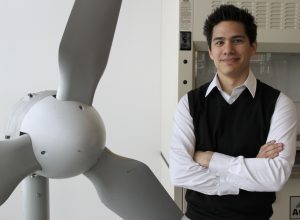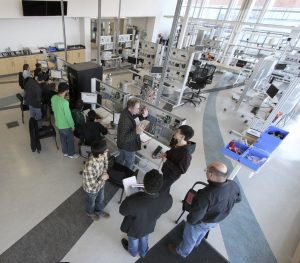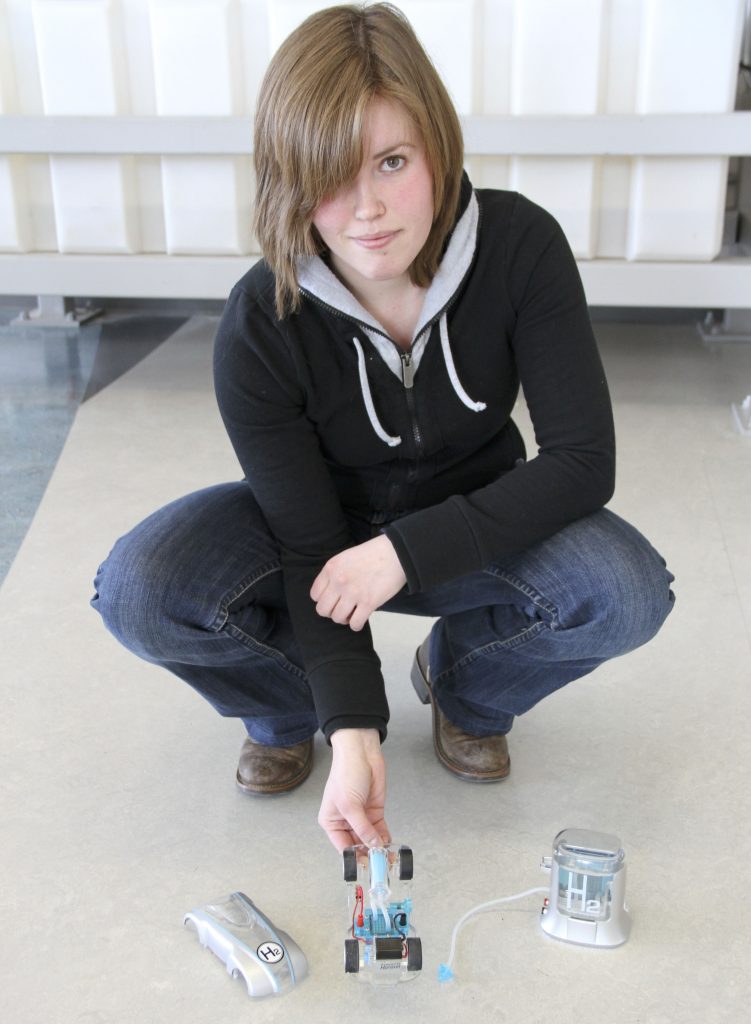By David Dodge and Duncan Kinney

David Dickie – wind instructor – NAIT alternative energy program. Photo by David Dodge, Green Energy Futures.
Kolton Kasur sees plenty of green in his future. The 22-year-old from rural Bashaw Alberta is enrolled in a new Alternative Energy Program at NAIT, a polytechnic school in Edmonton.
“I think there’s going to be a huge future in alternative energy as technology develops,” says Kasur. He believes there will be “a constant growing demand for energy as population increases; and there’s always going to be demand for more sustainable energy.”
The green and renewable energy industries are growing rapidly. Wind is growing about 20 per cent per year in Canada, According to the Canadian Wind Energy Association, Canada’s production of wind power is going to double in the next five years. Many people are surprised to learn that there are over 100,000 geothermal heating systems installed in homes and businesses across the country.
NAIT’s Alternative Energy Program aims to help meet this increasing demand. It’s a two-year program that teaches students how to design and install a broad range of green technologies ranging from solar to wind and even exotic technologies like fuel cells.

Kolton Kasur at the wind station in the NAIT alternative energy lab. Photo by David Dodge, Green Energy Futures.
There is a “definite knowledge gap out there regarding many of the green technologies,” explains instructor Don MacIntyre. He specializes in geothermal energy, a technology that uses the ground as a giant battery, drawing heat in the winter and cold in the summer.
“What NAIT is trying to do in this Alternative Energy Program is bring together a number of leading technologies in the area of green tech – bring them into a single curriculum and give the students enough of a knowledge of all of them to put them into the working world with a genuinely good understanding of how these technologies

NAIT students working on fuel cells in the alternative energy Lab.
actually work and work together,” says MacIntyre.
It was NAIT’s past-president, Sam Shaw, who helped establish the renewable energy program. He noticed an increasing number of Albertans were interested in purchasing renewable energy products, but there were few technologists trained to service the industry.
Shaw worked with NAIT employees and politicians, Rona Ambrose and Doug Horner. They raised $13.6 million and they built the program from the ground up or, more accurately, from the underground up. The NAIT Alternative Energy lab contains a working geothermal system that harvests heat from 53 metres (175 feet) beneath the earth. The system sends reports to a web interface that students can access and use as a learning tool.
The geothermal unit is just one of the flagship technologies in the expansive laboratory located at NAIT’s downtown campus. This lab is renewable-energy-geek heaven. It features solar photovoltaic systems that produce electricity. Solar simulators allow students to learn the effect clouds, shading, different latitudes, and even the changing seasons can have on solar power production. “We can simulate being in Cuba or the Northwest Territories,” explains program chair Jim Sandercock.
Another workstation simulates a Vestas V80 giant wind turbine. V80s feature blades that sweep a circle 80 metres in diameter. They can produce 2,000 kilowatts of electricity, enough to power about 1,000 homes in Alberta.
The lab’s solar thermal system is on the roof. It harvests heat from the sun and works in tandem with the geothermal system. “It’s actually quite rare to discover just a single green tech being used on… projects,” says MacIntyre. “Most of the time now we are seeing hybridization (of technologies).”

Rae-Anne Wadey a student in NAIT alternative energy program with a small, model fuel cell car that shows how fuel cells work.Photo by David Dodge, Green Energy Futures.
The lab includes stations that teach students about biofuels, energy storage and even a micro hydro simulator that pumps water up into an overhead tank so students can see how electricity is generated as the water pours down through small turbines. Students learn about six to eight kinds of fuel cells. In the lab students use working fuel cells to power lights. They fill metal hydride fuel bottles with hydrogen which feeds a stack of 10 small fuel cells.
NAIT invested in fuel cell technology in 2003, when it installed a 200 kW system that supplied 5-8 per cent of NAITs power needs. But the fuel cell only lasted nine years and was retired. Unlike most of the other technologies at NAIT the fuel cell is still relatively immature.
The green technologies in this classroom may seem to be outside the mainstream, yet Albertans are eager to learn about them. Last fall when NAIT announced the new Alternative Energy program, they received 144 applications for 24 spots.
“I enrolled in this program because I think that’s where the future’s leading to,” says Preetpau Atwal. She was born in Edmonton, grew up in India, and returned to Alberta about six years ago. She sees green technology as an answer to many environmental problems. “I wanted to make a positive change in the world.”
Kolton Kasur, the student from the farming community of Bashaw, sees a big future in green energy: “I’d like to graduate from the program, go and work for an established company for a number of years, and then hopefully be able to develop my own business installing and designing systems for primarily rural acreages and farms.”
Having qualified renewable energy technologists will definitely help overcome significant barriers to growth of the industry. It’s seems that NAIT’s graduates will both fill a need for expertise and they will also become entrepreneurs in the booming green energy markets in Ontario and the emerging markets in British Columbia, Alberta and other provinces.

Jim Sandercock, head of NAIT’s alternative energy program, teaches a class on biofuel science.


